Several years ago I built a portable puppet theater out of PVC and black fabric. We have used it since then for puppet shows at our church. Our church has different locations, so this is perfect for moving the theater back and forth to different spots where we have children’s worship services and summer activities. In a few months, a friend of mine will be borrowing it for a class she is teaching on puppetry at her elementary school.
It has been such a convenient and affordable way to get a big payoff in terms of doing puppets for and with kids that I thought it would be worth sharing with you how it was built. I hope this comes in handy to someone out there who wants to build their own.
Want more ideas on crafts and supplies you can use in performance settings? Sign up here for my free monthly newsletter. It is full of ideas about children’s ministry and performing, along with updates about my road travels.
Materials: The materials cost me around $150. And it helped that I have a mother who sews, so she volunteered the labor of making the black fabric pieces that hang on the PVC piping. Here is a list of what you will need:
- Four king-sized flat bed sheets (black color)
- Four 10-foot lengths of 2″ PVC piping (if you can only get 8-foot lengths, you’ll need to get seven pieces)
- Four T-couplings of 2″ PVC
- Four 90-degree elbow couplings of 2″ PVC
- Four flat caps of 2″ PVC
- Seven different colors of electrical tape (only about a foot of length needed for each color)
- A saw fit for cutting PVC
- Someone with basic sewing skills and a sewing machine (if you don’t have this, then you’ll need to find a way to attach the fabric to the stage on your own, which is very possible with some creativity)
Steps:
Step 1: Cut three of the 10-foot PVC lengths in half, leaving you with six 5-foot lengths.
Step 2: Cut the remaining 10-foot PVC length into the following: two 30-inch lengths, two 24-inch lengths, and two 2.5-inch lengths, and you should have some scrap remaining.
Step 3: Assemble the pieces into the design as seen in the pictures below. It is fairly simple, so study these pictures a bit and you’ll see how all the parts fit together. The caps are the feet of the four posts. The 5-foot lengths are the four posts and the two that go across from side to side. The 30-inch pieces are the front-back connectors. The 24-inch pieces are the height extensions on the back posts. The 2.5-inch pieces serve as a way to connect the T-couplings to the 90 elbow couplings on the front part of the stage. All of this makes the stage just over seven feet tall in the back and just under six feet tall in the front. It is about three feet deep.
Step 4: Take the four king sized black flat bed sheets and sew 2 sheets together and then the remaining 2 sheets together, so you are left with two pieces that are roughly 12-foot by 6-foot each. Then fold and sew a 5.5-inch” “tunnel” across the 12-foot length of the sheets. This tunnel will be large enough to slip over the 2-inch PVC.
Step 5: Color code all of your connections using the colored electrical tape. This helps for re-assembly when people unfamiliar with the stage are helping to set it up.
Step 6: Slip the sheets on using the tunnels as seen the pictures. Stand up the stage if you haven’t already. Get out your puppets and have fun!


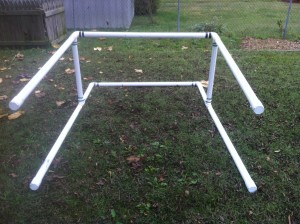
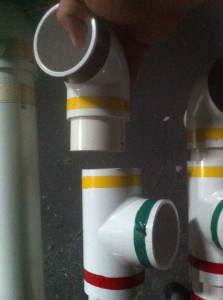
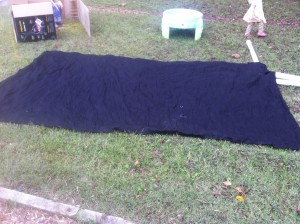

Want more ideas on crafts and supplies you can use in performance settings? Sign up here for my free monthly newsletter. It is full of ideas about children’s ministry and performing, along with updates about my road travels.
Need a speaker/entertainer for your next event? Get a free quote on my juggling show here. I travel full-time nationwide.



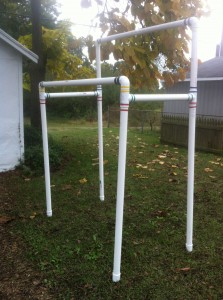
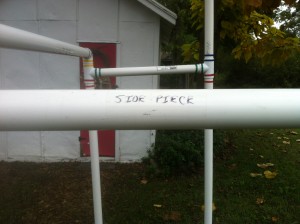

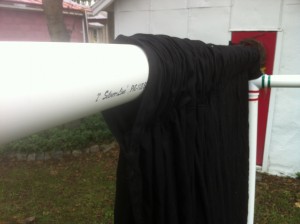
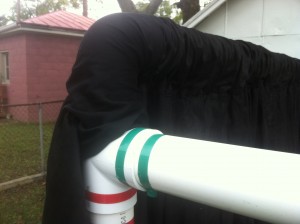
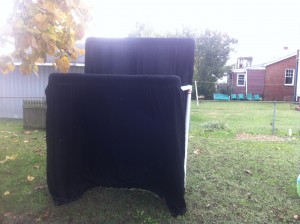
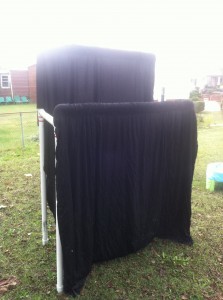
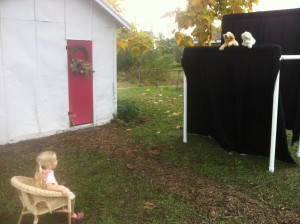
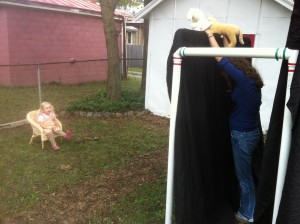


18 responses to “How to Build a Portable Puppet Theater”
Hi Jesse, my name is Audrey and I am trying to build a puppet stage for my ministry. I tried once building a stage from PVC piping but the problem I had was that it kept falling down and apart. My question to you is how do you keep them from happening with the one you build?
Audrey, thanks for asking. I use large pipes (2″ pipes) and when I connect them, I really shove them together into the couplings with all my might. Also make sure you use couplings and fittings that are deep. Some couplings are shallow, so the pipes only go a short distance into the fitting. It will fall apart if that’s the case. Make sure they are deep (compare the different types at the hardware store.
Hope that helps! Let me know if you have any other questions.
-Jesse
Thanks Jesse, I’ll let you know how it goes……
Audrey,
If you have a drill and bits for it you can also get cleves pins from your local tractor supply company… put it together then drill holes the size of the pins… slide the pins in and it will not come apart on you…
Hi Jesse,
I need to construct a puppet stage for three adult men (average weight and height) to use at one time. I like the look of your stage. Would it fit three men, or do I need to make it bigger?
Thank you!
~Michael
Hi, Michael. This stage is just big enough for three adult men. Four would be pushing it. Thanks for the question and let me know how it goes! -Jesse
Thanks Jesse!
Hi, my name is Allison Kim and I’m doing a Romeo and Juliet puppet show for my class project.
What brands do you use for the PVC pipes?
Thanks.
Hi, Allison. I use the stock pipes found at Lowes or Home Depot. I’m not near the pipes right now, so I don’t know the exact brand. But any line of white pipes in the sizes I mentioned should work fine.
Thanks!!
Hello! We are planning to do a puppet show for a religious/spiritual function. I am a part of the decorations committee, and the task for making the puppet show stage has fallen to me….
The Puppet Show Committee is asking for a stage that is
9 feet long, 6 feet high, and 4-5 feet deep.
The little kids will be practicing and putting on the show for everyone else, so there needs to be about a 2 foot riser as well.
I am wondering if I simply tweak your design, do you feel that the 2″ PVCs will hold that kind of increase of the sizes?
Thanks for your help!
-Shailee
Hi Shailee. Thanks for checking out the plans. That is quite a bit wider than mine, so I can’t say for sure since I’m not an engineer. The problem with going to a bigger PVC is that it increases the weight of all the pipes, which could make the stage wobble and maybe tip over if bumped the right way (at that size). I think you could stick with 2″ pipes, but reinforce the 9 ft width by adding a “T” support in the middle of the front piece and back piece. That means getting two more “T” pieces plus two more long pipes that go the entire height of your stage. Put those support beams in the middle of your horizontal front and back pieces using the “T”. You’ll have to cut those 9 ft horizontal pieces in half so you can add that “T” in there. I hope that makes sense! Let me know if you have any more questions. Thanks for reading my plans.
just sharing…i am going to make a puppet theater out of a metal, wheeled “garment rack with top and bottom shelves” that is 72″ high and 35”wide; the shelves are moveable so will move bottom rack up to be the stage; will sew material together to go over the rack, have opening for the stage with a back drop material behind stage area. i had done this previously using a 2-pole wheeled garment rack that had no shelves. the structure was not sturdy and had to have a make-shift stage placing a board in to be our stage. eventually, after all the wiggliness etc the plastic around the wheels cracked and it was a tangled mess. i would like it be as wide as yours, but think i will have to make do with our idea and can wheel into the pastors office after play. with the other rack, i could lower the poles down and place over to side of our piano for it to be out of the way for rest of church service.
I am trying to make a puppet stage for our youth and i have followed your directions but it doesnt seem stable. if you touch it on the end it rocks any ideas. dont really know what i am doing but i was given the project thank you for any help
Hi Virginia,
The one that I made did wobble a little bit, but not so much that I feared it would collapse or fall down. I’m assuming you used the right size pipes that I suggested. Any smaller would make it more shaky. Also, all the couplings and connection points – those are the most important in terms of stability. Really make sure all those fittings are tightly inserted into one another. You may need a hammer or mallet for some of them. Then when you break it down, get a friend to hold one pipe while you hold the other and twist it out. If your stage is semi-permanent (as in, you’re not going to set it up and break it down very often), then you can find some metal or plastic straps (that plumbers or HVAC people use) and strap the back of the puppet stage to a wall. I hope that helps! Let me know if you have any more specific details or any more questions.
You can also assemble the whole thing then drill holes through the joints and insert bolts with washers and wing nuts…. they tighten nicely by hand, and firm things up… It increases the set up time but is well worth it for peace of mind… One other thing you can do is this. You can get tee’s that have a 45* angle and place them on the main up rights about a foot off the floor facing the sides, then get PVC long enough to reach the floor from the 45* angles. Camp the ends and stuff them in the 45* angles. You now have down riggers to keep the whole thing from swaying side to side… Hope this helped and God Bless!
[…] How to Build a Portable Puppet Theater – Jesse Joyner – Several years ago I built a portable puppet theater out of PVC and black fabric. We have used it since then for puppet shows at our church. Our church has different … […]
[…] How to Build a Portable Puppet … – Here are some free plans and pictures for an affordable portable puppet theater that can accommodate multiple puppeteers. Enjoy! […]
This structure needs shears to maintain its shape–that is, triangles: diagonals bracing each side. The 45 degree T’s mentioned in a comment above should work to hold additional diagonal pieces: 8 T’s, then, and 4 diagonals between them. Otherwise, wobbling is absolutely inevitable, even if the joints are rammed tight, because the whole, being just a bunch of parallelograms, can deform into any angle!
Thanks for the input, Eliot. You are right that triangles would definitely strengthen the structure. I will say that it stands firm as is when left alone and used under normal puppet performance conditions. But if someone were to bump up against it forcefully from any direction, it would deform it more or less depending on the force applied.